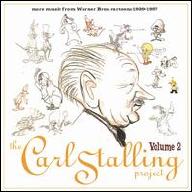Stalling was born in Lexington, MO in 1888; his musical education began in his infancy, as he spent hours upon end playing made-up songs on a broken toy piano. At the age of five, he saw Edwin S. Porter's early film landmark #The Great Train Robbery, and an all-consuming passion for the cinema was born; years later he was hired by the local movie house to play piano during intermissions and reel changes, and by the '20s was conducting his own orchestra and improvising music to accompany silent movies at the Isis Theater in Kansas City. There Stalling met Walt Disney, resulting in an invitation to score a pair of animated shorts; on cartoons like "The Skeleton Dance" (first of the #Silly Symphonies series), Stalling's soundtracks brought a new dimension to the Disney aesthetic, while in the studio, he developed a system called "ticking" which enabled individual orchestra members to keep in tempo by listening to a steady beat on headphones. His involvement in Disney's work ultimately grew so extensive that once, Stalling even dubbed Mickey Mouse's voice.
In 1930, Stalling left Disney to work under animator Ub Iwerks on the "Flip the Frog" series; six years later, he landed at Warner Bros., remaining the animation department's musical director for over two decades. Stalling's arrival coincided with the emergence of a golden age of Warner animation; under the supervision of producer Leon Schlesinger, who assembled a crack team of animators including Robert McKimson, Bob Clampett, Chuck Jones, Tex Avery, and Frank Tashlin, the studio's cartoons -- the #Merrie Melodies and #Looney Tunes series, respectively -- heralded a new era of inspired lunacy, with a stable of memorable characters like Daffy Duck and Porky Pig, as well as a brand of anarchic comedy far removed from Disney's gentility. With the 1937 arrival of voice-over master Mel Blanc, the nucleus of the studio's team was complete, and with the 1940 introduction of the character who later evolved into Bugs Bunny, the WB's flagship icon was born.
At Warners, Stalling scored some 600 cartoons in all; in addition to creating their distinctive opening sound effect -- a "boinnngggg!" achieved via an electric guitar chord -- he also established their distinctive theme songs using Merrily We Roll Along for the #Merrie Melodies series and The Merry-Go-Round Broke Down for #Looney Tunes. Working with Warner's 50-piece orchestra under the direction of conductor Milt Franklyn, Stalling scored each cartoon in about three hours at a staggering rate of at least one a week, absorbing the influences of current pop hits, classical symphonies, and the like, and then quoting whatever seemed to fit; over time, motifs began developing in his work -- drunken characters commonly stumbled about to the strains of How Dry I Am, Bugs Bunny's frequent appearances in drag were heralded by The Lady in Red, and bouts of hunger were accompanied by the obscure Billy Rose number A Cup of Coffee, A Sandwich and You.
No discussion of Stalling's work is complete without making mention of composer and bandleader Raymond Scott, whose visionary recordings of the late '30s, while never intended for use in conjunction with animation, remain the cornerstone of cartoon music. Stalling borrowed much from Scott, using his mechanized "Powerhouse" in the short "Mousemerized Cat" and, as a consequence, introducing a piece of music that would later resurface in #Ren and Stimpy and other programs; other Scott creations popularized through Warner cartoons included Dinner Music for a Pack of Hungry Cannibals. Nevertheless, Stalling himself surmised that as much as 80- or 90-percent of each score was entirely his own creation, as every composition needed to be perfectly synchronized to each moment onscreen; in his own compositions, bassoons, sliding trombones, odd viola effects, and violin glissandos all achieved roles of great prominence, at times even replacing the myriad sound effects produced by the great Treg Brown. After scoring 1958's To Itch His Own, Stalling retired; he died in 1974. ~ Jason Ankeny, Rovi













